
Unpeeling the Twists and Turns of the DEA’s Museum’s Contentious Exhibition
Debates around how the Drug Enforcement Administration (DEA) has influenced drug policy and legislation are tense, full of problems, and often riddled with confusion. Digging into these complex issues often uncovers shocking realities about the measures undertaken in the name of public safety. Taking a closer look at the DEA’s in-house museum serves as a puzzling exercise in unravelling the organization’s methods of sanitizing and glamorizing its checkered history.
A Glorified ‘Life of Service’
One of the complicated pieces around this DEA museum is how it represents Harry Anslinger, fondly remembered as a son of immigrants who became the Father of the drug war. Instead of discussing the confusing bits of Anslinger’s tenure — characterized by incredibly controversial and often racially-charged policies — the museum portrays him as a diligent lawman committed to creating a drug-free world. Crucially missing details paint a shadowy picture of how Anslinger’s approach to drug enforcement inflamed systemic inequalities and caused incalculable damage.
Brushing Over Outrageous Statements
Interestingly, none of Anslinger’s nerve-racking beliefs, such as his perpetrated lie that “Marijuana is an addictive drug which produces in its users insanity, criminality, and death,” made it into the museum exhibition. While politically expedient, this kind of omissions leaves the lay public poorly informed about the reality of marijuana use and its legalities.
Embarrassing Misinformation Around Marijuana
The museum stumbles into other overwhelming issues, such as its ‘Preventing Marijuana Use Among Youth & Young Adults’ pamphlet – loaded with misinformation. It underplays the therapeutic properties of CBD and overplays marijuana’s long-term negative effects. The facts about marijuana use and effects seem lost amidst the DEA’s need to project a particular narrative — a narrative that is often on edge with facts recognized by countless medical experts and researchers globally.
The Controlled Substances Act: Fine Points Often Overlooked
Another of the hidden complexities manifest in the DEA’s portrayal of the Controlled Substances Act. This representation fails to acknowledge that several substances listed under Schedule I, such as LSD, MDMA, and cannabis, have shown significant therapeutic potential. This attests to the DEA’s inability to accurately decide which substances can be prescribed — a small distinction with major implications.
Is this Child’s Play? Drug Education Gone Wrong
Unfortunately, the DEA’s attempts at engaging children with the ideology of prohibition surpasses complicated pieces to reach something more sinister. Through workbooks and ‘Drug Free Pledges’, the DEA strives, overwhelmingly, to normalize the idea of working for an agency often accused of violence and racism.
A Vortex of Confusing Narrative: The Absence of Important History
Strikingly, the DEA’s well-documented history — laced with instances of racism, violence, and corruption — is conspicuously absent from its museum. The question remains: why aren’t the tangled issues associated with the DEA explored in this space? Why are honest accounts of the agency’s role in mass incarceration, controversies related to its field operations, or the history of illegal activities by its former agents left out of the story?
The Unending Struggle: Abolishing the DEA, a Necessary Path?
Based on the level of misinformation and the deliberate brush-over on the trickier aspects of the DEA’s past, it might be justified to question if abolishing the DEA may well be a necessary path — a controversial viewpoint thriving amidst the grappling debate centering around drug enforcement policies globally.
Dealing with Drugs: Choosing Harm Reduction Over Criminalisation
Despite the unsettling revelations entailing the museum visit, it was heartening to see the suggestion cards filled by visitors advocating for harm reduction policies and policy changes. It seems that the general public might be fundamentally more open to embracing a realistic and compassionate approach to drug issues, rather than burying the challenges under the rug.
In conclusion, the DEA museum serves as a convoluted lens into the confusing world of enforcement histories — both revealing and intentionally obscuring the broader implications of drug policies that directly affect millions of lives across the United States and the world.
Originally Post From https://www.marijuanamoment.net/the-deas-official-museum-is-an-embarrassment-of-reefer-madness-misinformation-op-ed/
Read more about this topic at
The DEA’s Official Museum Is An ‘Embarrassment Of …
Tom Angell 🌳📰ⓥ (@tomangell) on …


